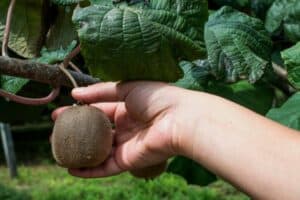Growing mandarin trees in containers is an ideal way to grow your own fruit if you have a small garden.
Potted mandarin trees are perfect for sunny balconies, courtyards and decks because you can move them around to catch the sun or protect them from bad weather.
Mandarins are smaller than oranges and easier to peel and split into segments which makes them an ideal healthy snack.
Here’s how to grow mandarin trees in pots.
This post contains affiliate links. Please read the disclosure for more info.

Mandarin varieties
There are many different types of mandarins that can be grown in containers including:
Imperial – one of the most popular varieties with sweet, juicy fruit that ripens in late fall to winter.
Clementine – a sweet, seedless variety that is alternate bearing, which means one year they produce a large crop followed by a smaller crop the next year.
Satsuma – a seedless mandarin variety originating from Japan. The fruit is small and sweet and the trees are suited to cool climates. [1]
Advantages of container mandarin trees
Potted mandarins are more compact in size than regular mandarin trees, which makes them perfect for small backyards.
You can even bring your potted mandarin tree indoors when the weather is cold.

How to grow mandarins in containers
The first step is to choose a large pot that is at least 18 inches (45 cm) deep.
This will allow the tree’s roots to spread out as it grows.
Place the pot on a plant stand with wheels which will allow you to move the tree around to get the best light.
You can also move the tree indoors during winter to protect it from frost, snow, hail and wind.
Choose a healthy looking mandarin plant from your local nursery or garden center.
It usually takes about two years for grafted mandarin trees to produce fruit but it’s definitely worth the wait to harvest your own home-grown mandarins.
Sunlight
Mandarin trees grow best in full sun, so choose a spot that receives at least 6 to 8 hours of sunlight each day.
Mandarin trees that receive plenty of sun will produce sweeter fruit.
Watering
Newly planted mandarin trees will need to be watered twice a week and more often during hot weather until they become established.
Mandarin trees are susceptible to root rot and fungal infections so it’s important to use well-draining potting soil and take care not to overwater them.
Fertilizer
Mandarin trees will need to be fertilized when the fruit starts to develop on the tree.
Use a liquid citrus fertilizer to help the tree produce an abundance of fruit.

Harvesting
Mandarins can be harvested from late fall to early spring, depending on the variety of mandarin you plant.
Mandarins are ready to pick when the skin color changes from green to orange.
Be careful not to leave the fruit on the tree for too long after it has turned orange because the fruit will go sour.
It’s always a good idea to do a taste test before you start harvesting the fruit.
Pruning
After the tree has finished fruiting you can prune it back to keep it tidy and manageable.
Remove any unhealthy looking branches and suckers that grow from the base of the plant.
Pruning mandarin trees leads to increased growth and increases fruit production for the following year.
Repotting
Mandarin trees will need to be repotted every year or two after planting until they reach full size.
Always choose a container that is at least 25% larger than the current pot and gently tease out the roots if the tree is root bound before replanting.
Pests
Mandarin trees can be affected by aphids, mites, scale and whiteflies.
It’s a good idea to check the leaves of your tree regularly and if you spot any insects spray the leaves with an insecticidal spray.

Overwintering container mandarin trees
If you live in an area with mild winter temperatures you can leave your mandarin tree outdoors in a sheltered spot that receives plenty of sun over the winter months.
In areas with harsh, cold winters, it’s best to move the tree inside for the winter where it will be protected from frost, snow and freezing temperatures.
Mandarin trees that are brought indoors over winter will need a brightly lit spot next to a sunny window.
How to eat mandarins
Fresh mandarins make the perfect snack when you’re on the go.
They’re easy to peel and the segments are a breeze to separate so you don’t get juice all over your hands like you do with oranges.
You can also add mandarin segments to fruit salads and garden salads, or you can preserve, cook or juice them.
Common questions
Are mandarin trees frost resistant?
Established mandarin trees are frost tolerant but young trees are susceptible to frost damage.
If there is a frost predicted when the tree is less than two years old you’ll need to cover the tree at night time or move it indoors until the threat of frost has passed.
So there are my tips for caring for mandarin trees in pots.
Hopefully this article has inspired you to grow a container mandarin tree at home.
With a large pot and a bit of care you can grow juicy fresh mandarins at home, even if you don’t have a garden.
RELATED ARTICLES
- 11 Best Fruit Trees To Grow In Containers
- 10 Climbing Fruit Plants
- How To Keep Birds Away From Fruit Trees
Have you tried growing mandarins in containers? Let me know in the comments below.
Are you on Pinterest? I have boards dedicated to Growing Fruit and Urban Gardening that you may enjoy. You can also find me on Facebook.






Thank you for your insight and help. I’m new to the garden and appreciate your style
Thanks Monty, I’m glad you found it helpful